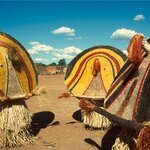Anthropology

If you were a linguist, how would you accurately describe 'click' sounds distinct to certain African languages? It's no easy task but in order to accurately preserve a language like N|uu, which has fewer than 10 remaining speakers (and all over age 60) linguists have to be able to document.
Cornell University professor Amanda Miller and colleagues recently used high-speed, ultrasound imaging of the human tongue to precisely categorize sounds produced by the N|uu language speakers of southern Africa's Kalahari Desert, a step toward understanding the physics of speech production.
The…

New genetic research in BMC Evolutionary Biology found telltale mutations in modern-day Indian populations that are exclusively shared by Aborigines. The new study indicates that Australian Aborigines initially arrived via south Asia.
Dr Raghavendra Rao worked with a team of researchers from the Anthropological Survey of India to sequence 966 complete mitochondrial DNA genomes from Indian 'relic populations'. He said, "Mitochondrial DNA is inherited only from the mother and so allows us to accurately trace ancestry. We found certain mutations in the DNA sequences of the Indian tribes we…

Neanderthals were stoutly-built and human-like and lived at the same time and in the same areas as some modern humans. But they went extinct.
Anthropologists have tried to solve the mystery of Neanderthal's fate since the first fossils were discovered in the small valley of the river Düssel called Neandertal, about 7 miles east of Düsseldorf in Germany.
Speculation is they they inter-bred with modern humans or failed to compete for food or resources or perhaps were even hunted to extinction by humans.
The wound that ultimately killed a Mesopotamian (modern day Iraq) 'Neanderthal…

Do friends wear the same clothes or see the same movies because they have similar tastes, part of the reason they became friends or, once a friendship is established, do individuals influence each other to adopt like behaviors?
Social scientists don't know for sure and are still trying to understand the role social influence plays in the spreading of trends because the real world doesn't keep track of how people acquire new items or preferences.
But the virtual world of "Second Life" does. Researchers from the University of Michigan have tried to use this information to study how…

Yesterday, the Brazilian national team overcame a 2 goal deficit to defeat the USA squad 3-2 in the final of the Confederations Cup. The unheralded USA team was a surprise but teams always are until they achieve big wins over a period of time. Then it becomes predictable and expected, like Brazil.
But what makes a great footballer? Being in excellent physical condition undoubtedly helps but few people actually believe that intense physical training alone can turn an average player into Cristiano Ronaldo - who is Portuguese. Instead, there is something…

Human brains have tripled in size over the past 2 million years, growing much faster than those of other mammals.
What might the reasons be for such dramatic brain expansion?
University of Missouri researchers studied three hypotheses for brain growth: ecological demand, social competition and climate change.
Yes, climate change. They're not stupid. An entire presidential cabinet is stuffed with carbon dioxide true believers so it's good diplomacy to at least consider global warming may make us devolve - that would be terrific marketing for a carbon trading scheme.…

A study involving giggling babies proves a closer connection between the primates. The study published in the journal, Current Biology, measured the giggling sounds of human infants and chimpanzees, concluding that we share the "human" emotional response of laughter with the great apes.
The results do not come as a huge surprise to the scientific community as chimpanzees, gorillas, humans and orangutans are all more closely related to each another than they are to the gibbons, or lesser apes. Baby chimpanzees and human infants emit the same giggling sounds when tickled…

One story goes that long ago, after the ice receded and the floodwaters lowered, Raven walked along a beach in Haida Gwaii, looking for occupation. He found some creatures in a shell and convinced them to come out. These were the first Haida, the first people, and they have lived here ever since.On your trip to Haida Gwaii, you'll enter the world of the Haida, arguably the most powerful pre-contact culture on the west coast of North America.

The arrival of cedar, called “Tsuuaay” by the Haida, had profound effects on the material culture of the Haida (Approx 4000 BC). Once they were able to build canoes to fish year round (Halibut, Red Snapper, Ling Cod etc) and could access sea mammals, they no longer only depended on the salmon to return at certain times. The cedar bent wood box, a genius idea in food conservation and storage, allowed them to store food for the winter and reduced their dependence on hunting land mammals throughout the year wained. The arrival of cedar marks a whole new stone tool tradition. The micoblades are…

Did animals teach us one of the oldest forms of human technology, basketry? Did that help us learn to count? These are just two of the themes due to be explored at a University of East Anglia event which takes place June 5-6) is part of Beyond the Basket, a new research project led by the university exploring the development and use of basketry in human culture over 10,000 years.
Basketry has been practiced for millennia and ranges from mats for sitting on, containers and traps for hunting, to partitions and walls - all of which have been central to advancing our culture.
Beyond the Basket is…